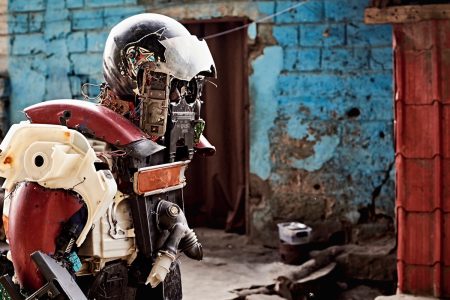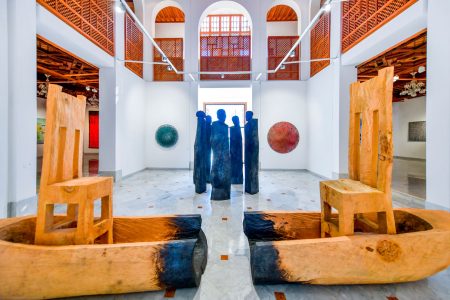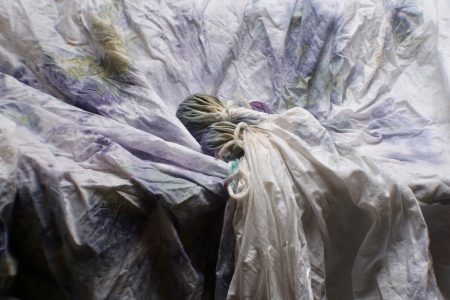Simon Njami – Dak’Art Biennale, towards Universality
A singular and rich encounter and dialogue with the artistic director of this 13th International Biennial of Contemporary African Art. In collaboration with something we Africans got.
You’re a man without a job, so what do you do in life?
Nothing.
Is your proposal for Dakar this year a continuation of the previous biennale?
Yes, I imagined it as a diptych.
Why did you decide to stay on? I thought you didn’t like indefinite African mandates?
Two mandates are okay. And it’s not a question of staying on here. When you make a diptych, you finish what you’ve begun. When I curated the first, I wanted to revisit Senghor. It was obvious to me that the second would focus on Senghor’s brother, Césaire.
Blue, red: is this an alchemical experiment?
It’s rubedo.
Meaning?
Alchemy, for the layman, comprises three stages: nigredo, albedo and rubedo. For specialists, there’s a fourth stage: citrinitas. So yes, alchemy too, even if it’s based on Césaire’s “Red Hour, the undone hour, red”. There’s also the letter “i” of Rimbaud’s Vowels. For him, this letter is red: “I, purples, spat blood, smile of beautiful lips. In anger or in the raptures of penitence.”
There is also a focus on time…
Absolutely. I believe we only think from a historical perspective, and I always create by starting out from myself. When you begin a project, the best solution is to start from a fixed point. Time is an essential element for me and I re-read: today is a future yesterday and a past tomorrow. Merleau-Ponty wrote that the gaze is at the heart of time. We say that time passes, but that’s not true. It’s we who pass. Time is like a sign that only takes on meaning once it’s looked at: it’s us who creates time. Time is an obsession for me, and if we don’t create things for the future bearing in mind our finitude, there will be no future possible. Finitude is what defines the future. People who say “everything, now” are ignorant of this obvious fact. They are caught in the neurasthenia of the instinctual moment, the instinct of death. Finitude is knowing that things will come to an end. We do things so that they continue after us. It’s a more open attitude than “everything, now”, which implies: “after me, the flood”.
But you distinguish your approach to time, to the day, to being on time?
No, I’ve always been on time. A day is a succession of 24 hours. There are two ways of envisaging time and mine is Omnes vulnerant, ultima necat (editor’s note: all hours wound, the last kills). And that can be applied to the time… It situates us in an Omnes, the variations of which are hard to distinguish. But there will be a last one. We don’t know when it will come, but knowing that it will forces us to live with the fact. It’s the end of all things, our own end, the end of the world, of a project. You cannot renew yourself without an awareness of finitude. That’s what distinguishes me from Paul Biya…
How is your book coming along? Is it ready for publication?
I like the end of cycles and I don’t like mixing genres. When you climb the Himalayas, you must get to the top before scaling Matterhorn, to put it in climbing terms. I like to do things with the greatest concentration possible. I like to finish things properly; it’s a question of time… All that is infinite, that is, unfinished, becomes unattainable and I like to attain. I don’t like dreamers whose dream isn’t efficient. I’m Deleuzian: I like efficient theory. Otherwise, Deleuze tells us, theory serves no purpose, and nor does the theoretician.
Yet your recent exhibitions have drawn on literature?
Yes, because I’m preparing myself… I’m a very organized person: I’m returning to my true loves.
So contemporary art is a mistress, then?
I take my mistresses very seriously. It’s a variation, contemporary art. It is literature to me; I simply write. An exhibition is simply the result of writing. My 1994 exhibition was called Another Country after Jimmy Baldwin. In 2010, it was called A Useful Dream after Tierno Monénembo. It’s not only recent, then. I suspect I have always been a literary person. As I wasn’t able to write things that could be qualified as literary anymore, I wrote things that were qualified as exhibitions.
Why can’t you write anymore?
It takes me a week to write a page, but I haven’t had seven consecutive days for 20 years now. I can easily think on a plane, but writing is about life – I mean novels. So I just write fragments of novels and they are my exhibitions.
You haven’t only written novels, though?
No. From time to time I want to tell the story of a person in their era. These people interest me because their time interests me. Biographies are novels in which these characters are the heroes, in the sense of the main character. That’s why I wrote these biographies, but it was like writing real novels in which I didn’t have the right to invent. And I am a child of Bison Ravi, whose incipit you’ll remember (editor’s note: Boris Vian, “This story is completely true since I made it up from beginning to end”). Fiction interests me in that it is more real than reality; it’s an enhanced reality.
Enhanced by…?
By manipulation; it’s taken to an extreme. I’m a writer, I decide, and the advantage is that I’m not a historian…
And this novel that’s finished?
It’s a novel that’s finished.
Coming back to the biennales…
To the root, then, as the pinnacle is the novel…
Looking back, what most marked you about the last Dak’art biennale?
Nothing that I didn’t already know. The fact that local Senegalese people visited the biennale right until its close, that’s what I worked towards. And what amuses me is that a lot of people came to witness what they have long dreamed of – the demise of Njami – and that was part of the equation. Some thought it was professional suicide. But I have no fascination for suicide.
When it comes to biennales, your proposals are always highly organic, and connected to their site of enunciation: cities at La Villette, etc. What was meant by your choice of the old Dakar courthouse?
It was crucial. One of the things that wasn’t working with the Dakar biennale was that there was no venue. They used to squeeze people into the IFAN. 50 artists aren’t a lot for a biennale, but were too many for the IFAN building. And I was itching to open up the courthouse. The place you put an exhibition on in is decisive. The old courthouse is a place where there were condemnations, weddings… it’s a site of memory. And when I first went inside, I knew I could put on a contemporary art biennale there. The site wasn’t easy… It was shut 30 years ago, as it was falling down, and yet it’s still standing. Of course it had to be surveyed, but I wouldn’t have done my biennale without this venue. This venue guided the rest, as you dance with the sites, you don’t violate them. It was all clear to me because I knew it was a place where I could dance. Half of the biennale’s success was down to the old courthouse.
Was it a kind of return to criminal law, which you started out in?
Not at all. What interested me wasn’t the criminal aspect, but the civil one. The most important aspect of a people’s memory is not the criminal, it’s the civil – not so much the grand gestures as the small ones: marriage certificates, birth certificates, divorces, fines. It was a court of law, with all of that. Not just a criminal court, but also the place of all of these family affairs, etc. When I went in the first time, it was the kingdom of goats, who were grazing on the files… But the building was sumptuous.
So, who is leading the dance?
What the kids who claim to be curators don’t understand is that the concept is a representation. A very fragile concept can give a truly beautiful exhibition, just as an impeccable concept can give something horrible. The idea is one thing, the exhibition is another and you are constrained by the venue. The space is obviously crucial: it’s what makes an exhibition if the dance is well executed. A space is immobile, so either I seduce it, or it rejects me. There are people who are in a hypertrophy of the self, and who want to dominate the space, when it’s simpler to negotiate.
Why opera in Uganda? You’ve gone from literature to musical literature for the Kampala Biennale…
It’s literature. Why do you add “musical”? Flaubert used to shut himself away in a room he called his “shouting chamber” to hear the words he’d written. Opera is sung poetry; in what way is it no longer poetry? Here, I’m art director. In Kampala, I conceptualize, I’m a librettist. I have written a story and then chosen the people to perform it. I don’t know the end; others will write it. Above all, I apply a multiplicity of things. If you’re going to put on a biennale in Kampala, why would you want to produce a replica of Venice? There’s one thing that’s very simple: transmission. That’s my libretto. Seven masters are opening their studios and the biennale will be the result. As I am someone political, I try to think, so why not think differently? We’re inviting seven artists, yet a biennale with less than 20 artists is ridiculous. These seven people are going to create a biennale in situ, and there’s this ancient notion of the Master’s transmission, in the sense of mentoring and initiation. What I’m interested in is changing the format, changing the story, forcing people to think. Transmission is about drawing on one’s experience and perpetuating it through others, differently. It’s a sort of self-renewal.
Robin Hood?
No, Zarathustra. I don’t take anything from anyone; I try things. If at my age – 56 – there’s nothing I want to explore, what’s the point? And if it works, it’s an organic biennale. Biennales, by nature, are every two years; that’s become a concept nowadays, so let’s revisit the concept. That’s freedom. Either I walk in my father’s footsteps, or what my father taught me allows me to find other paths… Changing the semantics forces people to question what a biennale is, what a librettist is, and suddenly the brain is set in motion again. And that’s all that interests me.
Coming back to your Dakar proposal, why have you introduced the idea of pavilions when you don’t like the national pavilions at Venice?
I don’t like the idea of the pavilion, but I’m fine with the idea of inviting. I’m an African: inviting people is one thing, creating territories is another. There are two things that I discovered at a young age: that I was one of the very few people who go to visit Africa, from South Africa to Algeria. I have physically been. Lots of people talk about Africa and I often have a problem with them. I’m talking about people from here: few Africans know Africa, yet that’s one of the functions of the biennale. If Dakar is a hub, the biennale must be the place where Africa convenes and where everyone comes to. The idea, then, is that the 54 countries come to Dakar and get to know Dakar. The Dakar biennale does ten times more than the pseudo African Union for African integration. Tunisia, for example, needs to come here and learn things. I’m not interested in the discourse; I’m interested in the getting it, that Africa knows its selves (editor’s note: deliberately in the plural). That’s why I’ve created pavilions for the invited countries. I believe that if Africa knew itself better, it would fare better. And there will also be a Senegalese Pavilion, which will not be a contemporary art pavilion, but a space in which Senegal display itself. We know things that we don’t realize, that no one teaches us, and that we have a duty to teach others.
Extract from the interview published in the magazine Something we Africans got #4
Intasgram: @somethingweafricansgot_art






